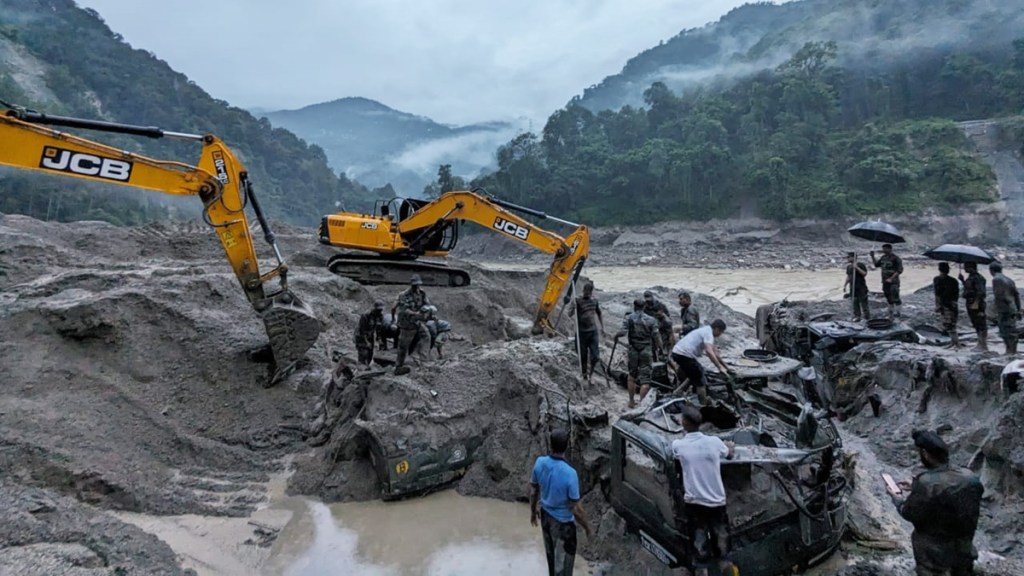A Glacial Lake Outburst in South Lhonak Lake in North Sikkim during the night of Oct 3-4, has triggered a devastating flood in the North Eastern State of Sikkim. The water level in the Teesta River surged by approximately 50-60 feet, resulting in catastrophic floods downstream.
Widespread damage to infrastructure, property, and tragic loss of human lives have been reported. As per the State Government’s estimate, a total of 142 individuals are currently missing, with 26 bodies recovered thus far. The precise assessment of the damage remains pending due to adverse weather conditions and continuous rainfall.
The Indian Army, stationed in the area, has also faced significant impacts, with several camps along the Teesta River’s banks sustaining damage or being swept away. At Burdang near Singtam, a vehicle parking area was inundated by the flash flood, submerging 23 soldiers and 39 vehicles that were temporarily halted there.
At the incident site, silt and mud, reaching heights of 30-40 feet, have buried most of the vehicles. A large-scale Search and Rescue operation was swiftly initiated, involving the Indian Army, BRO, NDRF, State Disaster Relief Teams, Para Military Forces, Police, Civil Administration, and the local population of Sikkim and North Bengal.
On the evening of Oct 4, villagers rescued one soldier from an area 18 km downstream of Burdang, and the individual is currently in stable condition under medical care.
As of now, a total of 26 bodies have been recovered from various locations along the river in North Bengal, and four bodies have been handed over by Bangladesh Border Forces.
Among the 26 recovered bodies, eight have been positively identified as Indian Army soldiers. The final rites for Naik Bimal Oraon from Alipurduar were conducted with full military honors on Oct 6th.
The remains of four soldiers will be transported to their respective hometowns on 7th Oct via service and civil aircraft for their last rites in the presence of family members.
Post-mortem examinations for two mortal remains are currently underway, while the search operation for the remaining 14 soldiers is ongoing.
Since Oct 6, bulldozers and plant equipment have been excavating the Burdang incident site. Radar technology, including the Leo Life Detector Radar and REECO Radar, along with Army Dogs, have also been deployed. Up to now, 15 out of 39 missing vehicles have been recovered. Reports of ammunition, explosives, and supplies belonging to the Indian Army from various camps swept away have been received from various places along the downstream river banks.
The Indian Army has issued advisories through civil administration and deployed lookout teams, along with State Police, to encourage locals to report any sightings of such items. Ammunition experts have been assigned to safely dispose of the recovered explosives.
National Highway 10 (NH 10), the lifeline of Sikkim, has been rendered unusable due to damage to the road surface and several bridges across the Teesta River. Work is currently underway to open and widen the Rangpo – Singtam road stretch.
Alternate routes to Gangtok are accessible via East Sikkim, while routes to West and South Sikkim remain open. However, in North Sikkim, roads beyond Mangan are currently inaccessible. On Oct 6, Lt Gen RP Kalita, GOC-in-C, Eastern Command, along with Lt Gen VPS Kaushik, GOC Trishakti Corps, conducted an aerial survey to assess the extent of damage and plan for relief efforts.
The Director General of BRO, along with Indian Army Engineers, NHIDCL, and State Government officials, are evaluating the damage and conducting surveys to restore road connectivity. Meanwhile, efforts are being made to establish a footbridge to connect Chungthang.
Helicopters from the Indian Army and Indian Air Force are conducting emergency supply and evacuation missions, although inclement weather and continuous rainfall have posed challenges to aerial operations.
Approximately 1500 tourists are estimated to be stranded in the Lachung and Lachen valleys in North Sikkim. The Indian Army, in collaboration with local administration, is providing assistance to stranded tourists and locals by offering food, medical aid, and satellite terminal-based telephone connectivity.
Teams have compiled data of all tourists staying in various hotels, and some of them have been accommodated in Army camps. Special helplines have been established at the Indian Army’s Trishakti Corps HQ, and family members of all stranded tourists have been notified about their well-being.
While the Sikkim hinterland has been severely affected, the operational situation along the Line of Actual Control (LAC) in Sikkim remains stable. The formations responsible for Border Management Posture are maintaining a high state of readiness and are adequately stocked in accordance with the sustainable operational logistics plan.
The Indian Army, in coordination with all relevant agencies and Civil Administration, continues its tireless Search & Rescue operations while concurrently focusing on the restoration of communication and other essential infrastructure in a well-coordinated manner.


